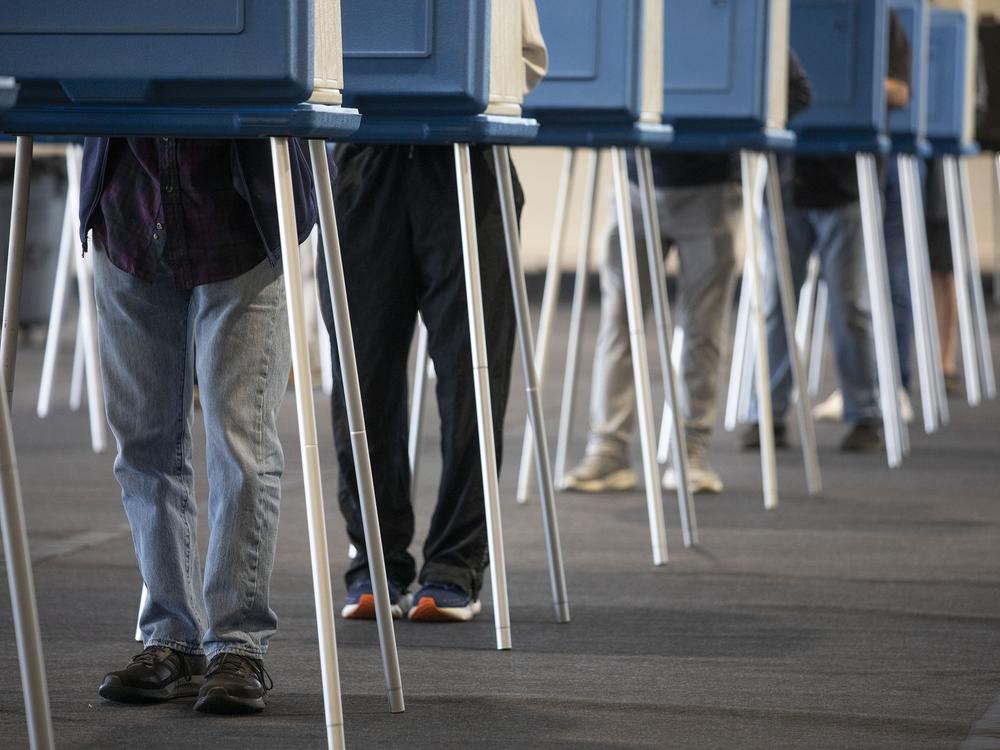Section Branding
Header Content
A simple truth is at the root of many false election claims: Voter rolls are imperfect
Primary Content
At the heart of many election conspiracy theories is a simple truth: America’s voter rolls are imperfect.
The U.S. doesn’t have a central voting list. It has a bunch of different lists. And they will always be slightly off.
Charles Stewart, an election data expert at MIT, remembers being at a conference 20 years ago, and an election official from Belgium was talking about voter rolls.
“He said, ‘The problem with you Americans is that you were never conquered by Napoleon,’” Stewart recalled. “Napoleon wanted to know where everybody was.”
In other words, many democracies have national voter lists. But in the decentralized U.S., lists are maintained at the state and local level, which leaves election officials across the country always trying to keep up with a population that moves and dies and is generally changing every single day.
That’s a difficult problem, especially when people are also skeptical of the government having too much of their information.
“Everybody talks about wanting government systems to all work seamlessly,” said Wesley Wilcox, a Republican who runs election in Marion County, Fla. “But in the same vein, you come back and say we don't want Big Brother knowing about this, that and the other.”
This fundamental data problem comes up in two major conspiratorial narratives around elections:
“There are more registered voters than eligible citizens”
This claim centers on the fact that tens of millions of Americans move every year. When they do, they aren’t automatically removed from their previous jurisdiction’s voter rolls. Federal law lays out a specific process for how voters can be removed from that prior roll that involves a set number of election cycles that need to pass before they can be purged.
That process takes time, meaning there is “deadwood” on every state’s voter rolls, as Stewart put it, but states are also constantly working to remove it within the bounds of the law. A report by the federal Election Assistance Commission found that in the two years between the 2020 presidential election and the 2022 midterms, states removed more than 19 million voter records from their rolls.
Still, false claims pop up every election related to these numbers.
Elon Musk, the owner of X and a leading purveyor of baseless election narratives, recently pushed a version of this claim about Michigan.
“Michigan has more registered voters than eligible citizens!?” he posted.
But his post left out that more than a million of the voters he was referring to were on Michigan’s “inactive” voter list, and therefore on their way to being deleted.
Michigan has 7.9 million voting age citizens, and 7.2 million active registered voters.
“Noncitizens are voting in big numbers”
This is the leading conspiracy theory of 2024, and a big part of why it sustains is because non-U.S. citizens do end up on voter rolls sometimes.
To be clear, every bit of research finds that noncitizens don’t vote in anything but microscopic numbers. The biggest deterrent is that any noncitizen who tries to vote risks deportation and puts their ability to ever naturalize in jeopardy.
“Do you really think they want to go to a government agency and show a photo and signature ID?” Wilcox, the Marion County election official, said about unauthorized immigrants. “They do not. They prefer that no one knows they're here.”
But noncitizens do end up on voting lists sometimes, usually as the result of bureaucratic errors.
Experts say automatic voter registration systems lead to cleaner voter rolls, but just this year, an error in rolling out Minnesota’s new system led to roughly 1,000 people who had not confirmed citizenship to the state being added to the voter rolls. The mistake was flagged, the registrations were removed, and new oversight processes were added.
“We immediately inactivated those records, but what remained was the problem of human error,” said Steve Simon, Minnesota’s Democratic secretary of state.
A similar issue was found and rectified in Oregon earlier this year.
These sorts of clerical errors don’t mean ineligible voters are actually casting ballots in large numbers (one study in Minnesota, for instance, found three convictions for noncitizen voting out of 13.4 million ballots cast from 2015 to 2024). But Simon noted how even isolated data errors can still feed false narratives about the process.
“It was very unhelpful,” he said. “I hope, notwithstanding that recent news, that people look at numbers … and they understand that the system really is one of integrity.”
One other difficulty when it comes to making sure noncitizens aren’t registered is there isn’t a single national database of all U.S. citizens either. So election officials are often cobbling together citizenship data from their DMVs, and trying to cross reference that against less-than-ideal resources offered by the federal government.
Like all solutions in election data, Stewart says, it isn’t perfect but it’s also getting better slowly.
“We have to come to this realization that we are not going to get perfect voter rolls,” he said. “We have damn good voter rolls. I think we have good voter rolls right now for the purposes for which they serve. Obviously, we could probably do better. But there are limits.”

